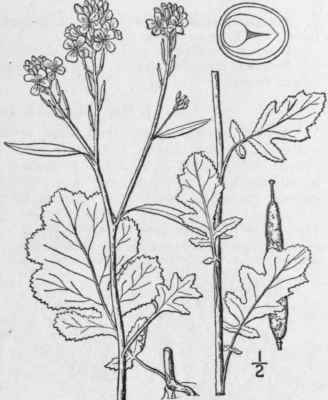41. Brassica [Tourn.] L. Sp
Description
This section is from the book "An Illustrated Flora Of The Northern United States, Canada And The British Possessions Vol2", by Nathaniel Lord Britton, Addison Brown. Also available from Amazon: An Illustrated Flora of the Northern United States, Canada and the British Possessions. 3 Volume Set..
41. Brassica [Tourn.] L. Sp
Pl. 666. 1753.
Erect branching annual, biennial or perennial herbs, with pinnatifid basal leaves, those of the stem dentate or often nearly entire, and showy yellow flowers in elongated racemes.
Siliques elongated, sessile, terete or 4-sided, tipped with an indehiscent conic beak. Valves convex, 1-3-nerved. Stigma truncate or 2-lobed. Seeds in 1 row in each cell, globose to oblong, marginless; cotyledons conduplicate. [Latin name of the Cabbage.]
A genus of about 80 species, natives of Europe, Asia and northern Africa. Type species: Brassica oleracea L.
None of the leaves clasping the stem, the upper sessile. | ||
Pods slender, 1/2' - 1' long, appressed; pedicels 2" long. | 1. | B. nigra. |
Pods rather slender, 1'-2' long, erect, on slender pedicels 3"-5" long. | 2. | B. juncea. |
Upper leaves clasping by an auricled base. | 3. | B. campestris. |
1. Brassica Nigra (L.) Koch. Black Mustar
Fig. 2105
Sinapis nigra L. Sp. Pl. 668. 1753. Brassica nigra Koch, in Roehl, Deutsche Fl. Ed. 3, 4:713. 1833.
Annual, erect, 2°-7° high, freely and widely branching, pubescent or glabrate. Lower leaves slender-petioled, deeply pin-natifid, with 1 terminal large lobe and 2-4 smaller lateral ones, dentate all around; upper leaves shorter-petioled or sessile, pin-natifid or dentate, the uppermost reduced to lanceolate or oblong entire blades; flowers bright yellow, 3"-5" broad; pedicels slender, appressed, 2" long in fruit; pods narrowly linear, 4-sided, 5"-7" long, 1/2" wide, appressed against the stems and forming very narrow racemes; beak slender, 1"-2" long; seeds dark brown.
In fields and waste places, common throughout our area, except the extreme north, west to the Pacific Coast. Bermuda. Naturalized from Europe. Native also of Asia. Cadlock. Warlock. Kerlock. Scurvy-senvie. June-Nov.


2. Brassica Jśncea (L.) Cosson. Indian Mustard
Fig. 2106
Sinapis juncea L. Sp. Pl. 668. 1753.
B. juncea Cosson, Bull. Soc. Bot. Fr. 6: 609. 1859.
Annual, pale, glabrous, or slightly pubescent, somewhat glaucous, stem erect, usually stout, 1°-4° tall. Lower leaves runcinate-pinnatifid and dentate, long-petioled, 4'-6' long, the uppermost sessile or nearly so, lanceolate or linear, commonly entire, much smaller; flowers 6"-9" wide; fruiting racemes sometimes 1° long; pods erect or nearly so, on slender ascending pedicels 3"-5" long, not appressed to the axis, 1'-2' long, more than 1" wide, the conic-subulate beak one-fourth to one-third the length of the body.
In waste places, New Hampshire to Pennsylvania, Michigan, Kansas and Virginia. Adventive or naturalized from Asia. May-July.
3. Brassica Campéstris L. Turnip. Wild Navew
Fig. 2107
Brassica campestris L. Sp. Pl. 666. 1753. Brassica Rapa L. Sp. Pl. 666. 1753.
Biennial; stem 1°-3° high, branching, glabrous and glaucous, or sometimes slightly pubescent below. Lower leaves petioled, pubescent, more or less lobed or pinnatifid; upper leaves lanceolate or oblong, acute or obtusish, sessile and clasping the stem by an auricled base, entire or dentate, glabrous; flowers bright yellow, 4"-5" broad; pedicels spreading or ascending, often I long in fruit; pods 1 1/2'-2' long, tipped with a beak 4"-5" long.
In cultivated grounds, sometimes persisting for a year or two, and occasional in waste places eastward. Fugitive from Europe. Summer-rape. Nape. Bergman's-cabbage. Coleseed. April-Oct. Consists of many races.

Brassica Nąpus L. (Rape) is like the preceding species but has all the leaves glabrous; sometimes found in waste places.
Brassica olerącea L. (Cabbage) is occasionally spontaneous after cultivation.
Brassica japņnica Siebold, occasionally spontaneous after cultivation, has laciniate, often crisped leaves.
Continue to:


